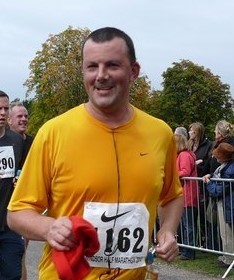Running Injuries, Running shoes and Running Styles
Posted on 6th May 2019 at 16:10
Over the last few years there has been quite a lot of debate about running styles or whether we should run with a shoe that provides maximal or minimal support to prevent running injury. Although characteristic of running style or running shoe may have some influence on injury the majority of non-traumatic running injuries that I see in clinic are predominantly due to excessive increases of running load (run distance/time) or a lack of consistency of running load.
Examples of these presentations could be a client who is training for a marathon and has got behind with their training programme, then suddenly increases their weekly mileage; or a regular 3-4 day a week runner not training for 2-3 weeks and then returning to their previous running schedule.

These types of injuries can usually be addressed by finding a comfortable running load that reduces run distance/time parameters allowing for continued participation in running and allow for the runner’s discomfort to diminish. Stopping running is not always the best option. Once this load is pain free or the runner can tolerate the level of discomfort, the load can be increased by 10% provided discomfort does not increase. Current research suggest soft tissues can tolerate changes in load of up to 10%.
In situations where symptoms are persisting looking at characteristics of running styles which may predispose injured tissue to more load can be useful.
Before making changes in running style or equipment it must be recognised that the body self- optimises to your own style, tissue that is loaded the most will attempt to get stronger and muscles used will adapt to use energy and produce force more efficiently and effectively. A sudden overhaul of style is likely to involve tissues that are less strong and muscles that have not adapted to the new style causing greater loads and possible damage to these tissues. A sudden change in the characteristics of a running shoe would also have this effect.
Given this point it makes sense that any change in running style to assist recovery from injury should be gradually introduced. This can be achieved by trying to change one characteristic of your running style for 1 minute of every mile you run rather than all at once and not suddenly purchasing a completely different running shoe in the hope that it will immediately fix the problem.
In the next few weeks I will be highlighting some characteristic of running styles which can be modified to assist with injury recovery.
Craig Fowlie
Senior Physiotherapist
MSc Sports and Exercise Medicine (Distinction) BPHTY(Hons), MCSP, MAACP
Member of the HCPC
Colchester Physiotherapy and Sports Injury Clinic
Author
Craig Fowlie

Craig is a highly specialized physiotherapist with post graduate qualifications in Acupuncture and Sports and Exercise Medicine.
He has worked with Professional Rugby sides in New Zealand and has assisted Great Britain Table Tennis at the World Team Championships and Olympic Qualifiers in Qatar and Germany. He is a consultant for the Governments Talented Athlete Scholarship Scheme and has published and presented research in the Journal of Physiotherapy and the Chartered Society of Physiotherapy Annual Conference.
Outside of work he enjoys participating socially in triathlon and running.
Share this post:






